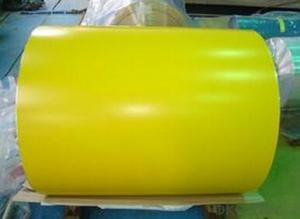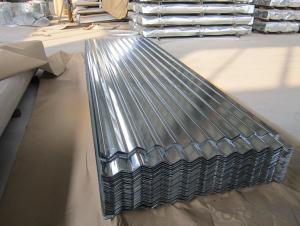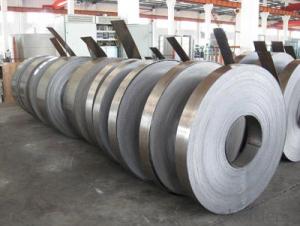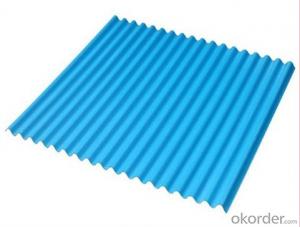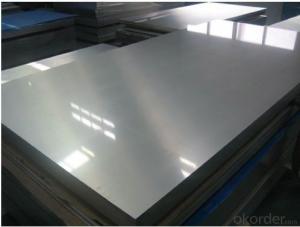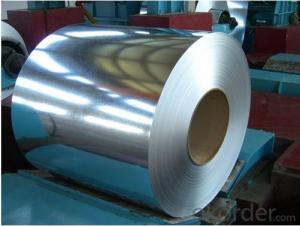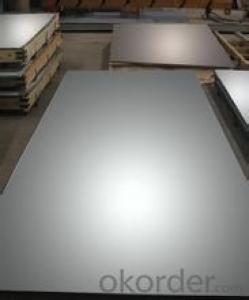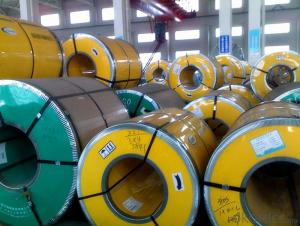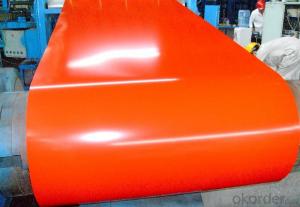Best Prepainted Galvanized steel Coil JIW
- Loading Port:
- Tianjin
- Payment Terms:
- TT OR LC
- Min Order Qty:
- 11 m.t.
- Supply Capability:
- 11 m.t./month
OKorder Service Pledge
OKorder Financial Service
You Might Also Like
Item specifice
1.Structure of Prepainted Galvanized steel Coil :
With Gi as base metal,after pretreatmet (degrease and chemical treatment) and liquid dope with several Layers of color,then after firing and cooling,finally the plate steel is called prepainted galvanized steel ( PPGI) .Prepainted galvanized steel is good capable of decoration ,molding,corrosion resistance The carbon in typical steel alloys may contribute up to 2.1% of its weight. Varying the amount of alloying elements, their formation in the steel either as solute elements, or as precipitated phases, retards the movement of those dislocations that make iron comparatively ductile and weak, and thus controls qualities such as the hardness, ductility, and tensile strength of the resulting steel. Steel's strength compared to pure iron is only possible at the expense of ductility, of which iron has an excess.
2.Main Features of Prepainted Galvanized steel Coil:
• Excellent process capability
• Smooth and flat surface
• Workability, durability
• Excellent heat resistance performance
• High strength
• Good formability
• Good visual effect
Although steel had been produced in bloomery furnaces for thousands of years, steel's use expanded extensively after more efficient production methods were devised in the 17th century for blister steel and then crucible steel. With the invention of the Bessemer process in the mid-19th century, a new era of mass-produced steel began. This was followed by Siemens-Martin process and then Gilchrist-Thomas process that refined the quality of steel. With their introductions, mild steel replacedwrought iron.
3.Prepainted Galvanized steel Coil Images
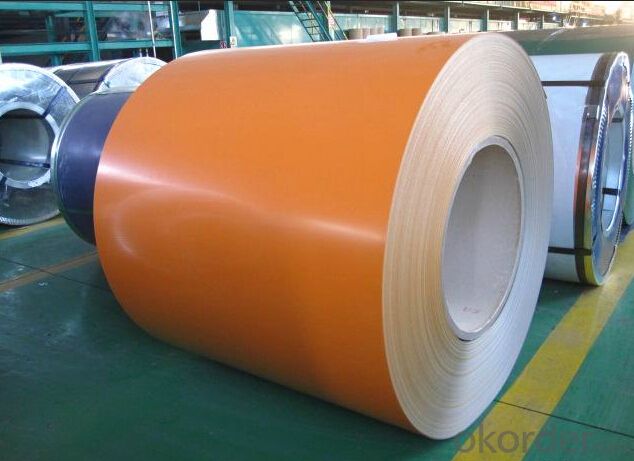
4.Prepainted Galvanized steel Coil Specification
Standard:ASTM, GB,JIS,JIS G3302 ASTM 755 EN10169
Grade: DX51D CGCC CS
Thickness: 0.13mm~3.0mm,
Width: 1250,600-1250mm
Coil weight:3-12 MT
Coil ID:508/610mm
Chemical composition:
C | Si | Mn | Cr | Ni | P | S |
0.150 | 0.476 | 11.231 | 12.50 | 0.900 | 0.039 | 0.010
|
5.FAQ of Prepainted Galvanized steel Coi
We have organized several common questions for our clients,may help you sincerely:
1.How do you control your quality
We have established the international advanced quality management system,every link from raw material to final product we have strict quality test;We resolutely put an end to unqualified products flowing into the market. At the same time, we will provide necessary follow-up service assurance.
2.how long we will receive the goods ?
After receiving your deposit or workable lc ,our normal shipment date is 15-20days,and it takes around 28 days to reach your port of destination. But is up to different destination
3. what is your moq
Normally our moq is 25per size ,but it is up to different size
- Q:What are the advantages of using steel strips in construction?
- There are several advantages of using steel strips in construction: 1. Strength and durability: Steel is one of the strongest and most durable materials available for construction. Steel strips provide structural integrity and can withstand heavy loads and extreme weather conditions, making them ideal for use in various construction applications. 2. Versatility: Steel strips can be customized and shaped according to specific requirements, making them versatile for a wide range of construction projects. They can be used for various purposes such as framing, roofing, flooring, and cladding. 3. Cost-effective: While steel strips may have a higher initial cost compared to other construction materials, they offer long-term cost savings. Steel is low-maintenance, resistant to corrosion, and has a long lifespan, reducing the need for frequent repairs and replacements. 4. Fire resistance: Steel is non-combustible and does not contribute to the spread of fire. This makes it a safer choice for construction, especially in buildings where fire safety is a priority. 5. Sustainability: Steel is an environmentally friendly material as it is highly recyclable. Steel strips can be recycled and reused multiple times without losing their properties, reducing the demand for new materials and minimizing waste. 6. Speed of construction: Steel strips are pre-fabricated off-site, which allows for faster construction times. This can help reduce project timelines and costs, making it an attractive option for commercial and industrial construction projects. 7. Design flexibility: Steel strips offer design flexibility, allowing architects and engineers to create unique and innovative structures. They can be easily combined with other construction materials to achieve desired aesthetics and functionality. Overall, the advantages of using steel strips in construction include their strength, durability, versatility, cost-effectiveness, fire resistance, sustainability, speed of construction, and design flexibility. These benefits make steel strips a popular choice for a wide range of construction projects.
- Q:Are steel strips suitable for making hand tools?
- Yes, steel strips are suitable for making hand tools. Steel is widely used in the manufacturing of hand tools due to its excellent strength, durability, and resistance to wear and tear. Steel strips can be easily shaped and formed into various hand tool designs, such as wrenches, pliers, screwdrivers, and hammers. The hardness of steel makes it ideal for tools that require a sharp cutting edge or a strong gripping surface. Steel strips can be heat-treated to increase their hardness and toughness, providing the necessary strength and durability for heavy-duty applications. Additionally, steel is highly resistant to corrosion, which ensures that hand tools made from steel strips will have a longer lifespan and remain functional even in harsh environments. Furthermore, steel strips can be easily machined or ground to achieve precise dimensions and tolerances required for hand tools. This allows manufacturers to create hand tools with accurate measurements, ensuring proper fit and functionality. Steel is also a cost-effective material, making it a popular choice for producing hand tools that are affordable for consumers. Overall, steel strips are highly suitable for making hand tools due to their strength, durability, resistance to wear and tear, and ease of shaping and forming. Hand tools made from steel strips provide reliable performance, longevity, and affordability, making them a preferred choice for professionals and DIY enthusiasts alike.
- Q:Can steel strips be used in the production of metal fences?
- Yes, steel strips can be used in the production of metal fences. Steel strips are commonly used to construct the frame and panels of metal fences due to their strength, durability, and resistance to corrosion. They provide the necessary support and stability to the fence structure, ensuring its longevity and security.
- Q:What is the tensile strength of a steel strip?
- The tensile strength of a steel strip refers to its ability to resist breaking or becoming permanently deformed when subjected to tension. The strength of the steel strip can vary depending on factors such as the composition of the steel, its processing, and any additional treatments or coatings applied. Generally, steel strips have a high tensile strength, ranging from 400 to 2,000 megapascals (MPa), or 58,000 to 290,000 pounds per square inch (psi). However, the exact tensile strength can vary depending on the specific grade and type of steel being used. Therefore, it is important to consult the manufacturer's specifications or conduct relevant tests to determine the exact tensile strength of a particular steel strip.
- Q:How are steel strips priced in the market?
- The market sets the price of steel strips based on various factors. Primary determinants include the cost of raw materials, manufacturing and processing expenses, supply and demand dynamics, market competition, and global economic conditions. Raw material costs, such as iron ore and other alloying elements, play a significant role in determining steel strip prices. Changes in these input costs directly impact the final pricing. Manufacturing and processing expenses, including labor, energy, and transportation, are also considered when determining the price. Supply and demand dynamics affect steel strip pricing as well. High demand and limited supply lead to higher prices due to scarcity. Conversely, a surplus in the market can result in lower prices as manufacturers compete for customers. Market competition is another factor affecting steel strip prices. When there are many suppliers, competition drives prices down as companies try to attract customers. Conversely, if there are fewer suppliers and limited competition, companies have more control over pricing. Global economic conditions also impact steel strip pricing. Economic growth or recession in major steel-consuming industries, such as construction, automotive, or manufacturing, influence the demand for steel strips. Currency exchange rates, trade policies, and geopolitical events can also affect pricing. In conclusion, steel strip pricing is determined by a combination of raw material costs, manufacturing and processing expenses, supply and demand dynamics, market competition, and global economic conditions. Understanding these factors is crucial for both suppliers and buyers to make informed decisions in the steel strip market.
- Q:How do steel strips respond to different surface painting processes?
- Steel strips respond differently to different surface painting processes depending on the method used. Some common processes include powder coating, electroplating, and spray painting. Each process has its own advantages and disadvantages. Powder coating provides a durable and uniform finish, while electroplating offers excellent corrosion resistance. Spray painting allows for customization and flexibility, but may lack the same level of durability and protection. Ultimately, the choice of painting process depends on the desired aesthetic, performance, and cost considerations.
- Q:How are steel strips joined together in manufacturing?
- In the field of manufacturing, various techniques are employed to join steel strips together, depending on the specific application and requirements. Welding is a commonly utilized method, where the edges of the steel strips are heated and fused together under high heat and pressure. This results in a robust and long-lasting bond between the strips. Another frequently employed technique involves the use of mechanical fasteners such as screws, bolts, or rivets. These fasteners are inserted through holes in the steel strips and tightened, effectively securing the strips together. This method allows for effortless disassembly and reassembly, if necessary. Moreover, adhesives can also be used to join steel strips. Industrial-grade adhesives are applied between the strips and, once they have cured, they form a strong bond that holds the steel strips together. Adhesive bonding is particularly favored for its ability to evenly distribute stress across the joint, resulting in a stronger overall structure. In addition, there are alternative methods like clinching or crimping, which involve deforming the edges of the steel strips to interlock them. This creates a secure connection without requiring additional materials such as welding rods or fasteners. The choice of joining method depends on various factors including the type of steel, desired strength and durability of the joint, cost considerations, and specific application requirements. Manufacturers meticulously select the most suitable joining technique to ensure that the steel strips are firmly joined together, meeting the desired specifications and quality standards.
- Q:How are steel strips coated with protective coatings?
- The process of steel coil coating enables the application of protective coatings onto steel strips, enhancing their durability and resistance to damage caused by corrosion, abrasion, and other factors. To begin the coating process, the steel strip is thoroughly cleaned and prepared. This step is crucial in order to eliminate any contaminants like dirt, oil, or rust that may hinder the adherence of the protective coating. The cleaning process can involve mechanical techniques, chemical treatments, or a combination of both. Once the steel strip is clean, the protective material is applied. Different methods can be used for this purpose, including roller coating, spray coating, or dip coating. Roller coating ensures an even application of the coating material by passing the steel strip through a series of rollers. Spray coating, on the other hand, involves using a high-pressure spray gun to apply the coating in a controlled manner. Dip coating entails immersing the steel strip into a bath of the coating material to achieve full coverage. After the coating is applied, the steel strip is typically cured or dried to promote proper adherence and the formation of a durable protective layer. This can be accomplished through various methods such as oven curing, infrared heating, or air drying, depending on the specific coating material used. The choice of protective coating material depends on the intended application and the desired level of protection. Organic coatings like paints, lacquers, or polymers, as well as inorganic coatings like metallic or ceramic coatings, are commonly used to protect steel strips. Each type of coating offers distinct properties and advantages, such as corrosion resistance, weatherability, scratch resistance, or chemical resistance. In conclusion, the process of coating steel strips involves cleaning and preparing the surface, applying the coating material using techniques such as roller coating, spray coating, or dip coating, and then curing or drying the coating to ensure its durability. The selection of the coating material depends on the desired level of protection and the specific application.
- Q:What are the physical properties of steel strips?
- Steel strips have several physical properties that make them desirable for a wide range of applications. Firstly, steel strips are known for their high strength and durability. This is due to the inherent strength of the steel material itself, which allows the strips to withstand heavy loads and resist deformation. The strong nature of steel strips makes them suitable for use in structural applications where strength is crucial, such as in construction and manufacturing industries. Additionally, steel strips have excellent ductility, meaning they can be easily stretched or bent without breaking. This property allows for greater flexibility in the design and fabrication of various products. Steel strips can be formed into different shapes and sizes, making them highly versatile and adaptable to different manufacturing processes. Steel strips also have good thermal conductivity, which means they can efficiently transfer heat. This property is particularly important in applications where heat needs to be dissipated or transferred, such as in heat exchangers or electrical components. The high thermal conductivity of steel strips ensures that heat is effectively spread and dispersed, preventing overheating and potential damage. Furthermore, steel strips exhibit a high melting point, making them resistant to heat and fire. This characteristic is crucial in applications where materials are subjected to extreme temperatures, such as in aerospace or automotive industries. Steel strips can withstand high temperatures without losing their structural integrity, ensuring the safety and reliability of the products they are used in. Lastly, steel strips are generally corrosion-resistant, particularly when they are coated with protective finishes. This property allows the strips to be used in outdoor or corrosive environments without experiencing significant degradation. The corrosion resistance of steel strips ensures their longevity and durability, reducing the need for frequent maintenance or replacement. In summary, the physical properties of steel strips include high strength, good ductility, excellent thermal conductivity, high melting point, and corrosion resistance. These properties make steel strips a preferred material for a wide range of applications, including construction, manufacturing, heat transfer, and more.
- Q:How are steel strips tested for internal defects?
- Steel strips are tested for internal defects using various non-destructive testing (NDT) methods. One common technique is ultrasonic testing, which involves sending high-frequency sound waves through the steel strip and measuring the time it takes for the waves to bounce back. Any inconsistencies or defects within the material will cause the sound waves to reflect differently, allowing technicians to identify internal flaws such as cracks, voids, or inclusions. Another method used is magnetic particle inspection, which relies on the principle of magnetism. A magnetic field is created around the steel strip, and if there are any defects present, they will disrupt the magnetic field, causing magnetic particles to cluster around the defect. This makes the flaw visible and easily detectable. Eddy current testing is another widely used technique. It involves passing an alternating current through a probe that is placed near the steel strip's surface. Any internal defects will cause a change in the electrical conductivity of the material, which in turn alters the eddy currents flowing within it. This change is detected by the probe, allowing for the identification of internal flaws. Other methods such as radiographic testing, which utilizes X-rays or gamma rays to penetrate the steel strip and produce an image of its internal structure, or dye penetrant inspection, which involves applying a colored liquid dye to the steel's surface and observing if it seeps into any cracks or defects, are also employed depending on the specific requirements and characteristics of the steel strips. These non-destructive testing methods are crucial in ensuring the quality and integrity of steel strips, as they allow for the reliable detection of internal defects without damaging the material. By identifying these flaws early on, manufacturers can take appropriate actions to rectify or remove defective strips, thereby preventing potential failures or accidents in the future.
1. Manufacturer Overview |
|
|---|---|
| Location | |
| Year Established | |
| Annual Output Value | |
| Main Markets | |
| Company Certifications | |
2. Manufacturer Certificates |
|
|---|---|
| a) Certification Name | |
| Range | |
| Reference | |
| Validity Period | |
3. Manufacturer Capability |
|
|---|---|
| a)Trade Capacity | |
| Nearest Port | |
| Export Percentage | |
| No.of Employees in Trade Department | |
| Language Spoken: | |
| b)Factory Information | |
| Factory Size: | |
| No. of Production Lines | |
| Contract Manufacturing | |
| Product Price Range | |
Send your message to us
Best Prepainted Galvanized steel Coil JIW
- Loading Port:
- Tianjin
- Payment Terms:
- TT OR LC
- Min Order Qty:
- 11 m.t.
- Supply Capability:
- 11 m.t./month
OKorder Service Pledge
OKorder Financial Service
Similar products
New products
Hot products
Hot Searches
Related keywords
